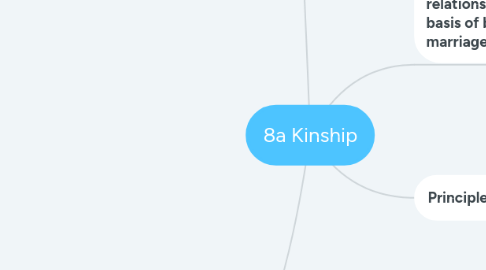
1. TERMS
1.1. Family of Orientation
1.1.1. Nuclear family in which one is born and grown
1.2. Family of Procreation:
1.2.1. Nuclear family established when one and has children
1.3. Nuclear family
1.3.1. Parents and their children
1.4. Extended family
1.4.1. Household with more than three generations
1.4.1.1. Example: Aunts, uncles, cousins, grandparents
1.5. Culturally specific kinship terms
1.5.1. Genitor/Genitrix:
1.5.1.1. a biological parent
1.5.2. Pater/Mater:
1.5.2.1. socially designated parent of a child
1.5.3. Apical ancestor/ancestress:
1.5.3.1. eldest known relative
1.6. Affinal (affines)
1.6.1. related by marriage (in-laws)
1.7. Agnatic (agnates):
1.7.1. related through the male line
1.8. Descent group:
1.8.1. group based on shared ancestry
1.9. Collateral kin
1.9.1. non-lineal relations such as siblings, aunts/uncles, cousins
1.10. Fictive kin
1.10.1. social relations that approximate affinal or consanguineal relations
1.11. Kindred
1.11.1. one’s family and relations
2. Classification and Culture
2.1. The functions of a Kinship System
2.1.1. Outlines rights and obligations
2.1.2. Specifies how people act toward each other
2.1.3. Determines the types of social groups that are formed
2.1.4. Regulates the systems of marriage and inheritance
2.2. Descent Groups
2.2.1. Consanguineal kin: lineal descendants of an apical ancestor
2.2.1.1. organize domestic life
2.2.1.2. organize domestic life
2.2.1.3. enculturate children
2.2.1.4. facilitate transfer of property
2.2.1.5. carry out religious rituals
2.2.1.6. settle disputes
2.2.2. Descent kin
2.2.2.1. Unilineal
2.2.2.1.1. no overlap, most prominent type; parallel cousins distinguished from cross cousins
2.2.2.1.2. Advantages:
2.2.2.2. Ambilineal Descent
2.2.2.2.1. a form of bilateral descent in which an individual may choose to affiliate with either the father’s or mother's descent group
2.2.2.3. Bilateral
2.2.2.3.1. overlap; more kin; all cousins treated the same
2.2.2.3.2. System under which both maternal and paternal lines are used in reckoning descent
2.2.2.4. Non-unilineal Descent
2.2.2.4.1. Any system of descent in which both father’s and mother’s
2.2.2.4.2. Cognatic Descent: any non-unilineal system of descent
2.3. Lineages and Clans
2.3.1. Lineage
2.3.1.1. Group of kin whose members trace descent from a known common (apical) ancestor.
2.3.2. Clan
2.3.2.1. unilineal kinship group whose members believe they are descended from a common ancestor (often an animal “totem”) but can’t trace the link through known relatives
2.3.2.1.1. Totem
2.3.2.1.2. regulate marriages through rules of exogamy
2.3.3. Phratry
2.3.3.1. unilineal descent group composed of clans whose members feel themselves to be closely related
2.3.4. Moeity
2.3.4.1. the halves of a community with only two descent groups
2.3.4.1.1. can be patrilineal or matrilineal
2.3.5. Kinship Terminology
2.3.5.1. Kinship terminologies are native taxonomies, developed over generations by the people who live in a particular society
2.3.5.2. Four major ways as distinguished by anthropologists
2.3.5.2.1. lineal
2.3.5.2.2. generational
2.3.5.2.3. bifurcate merging
2.3.5.2.4. bifurcate collateral
3. Definition: culturally defined relationship established on the basis of blood or through marriage ties
3.1. Functions of Kinship
3.1.1. Provides continuity between generations
3.1.1.1. inheritance (property)
3.1.1.2. succession (power or rank)
3.1.2. Defines a group on which a person can rely for aid
